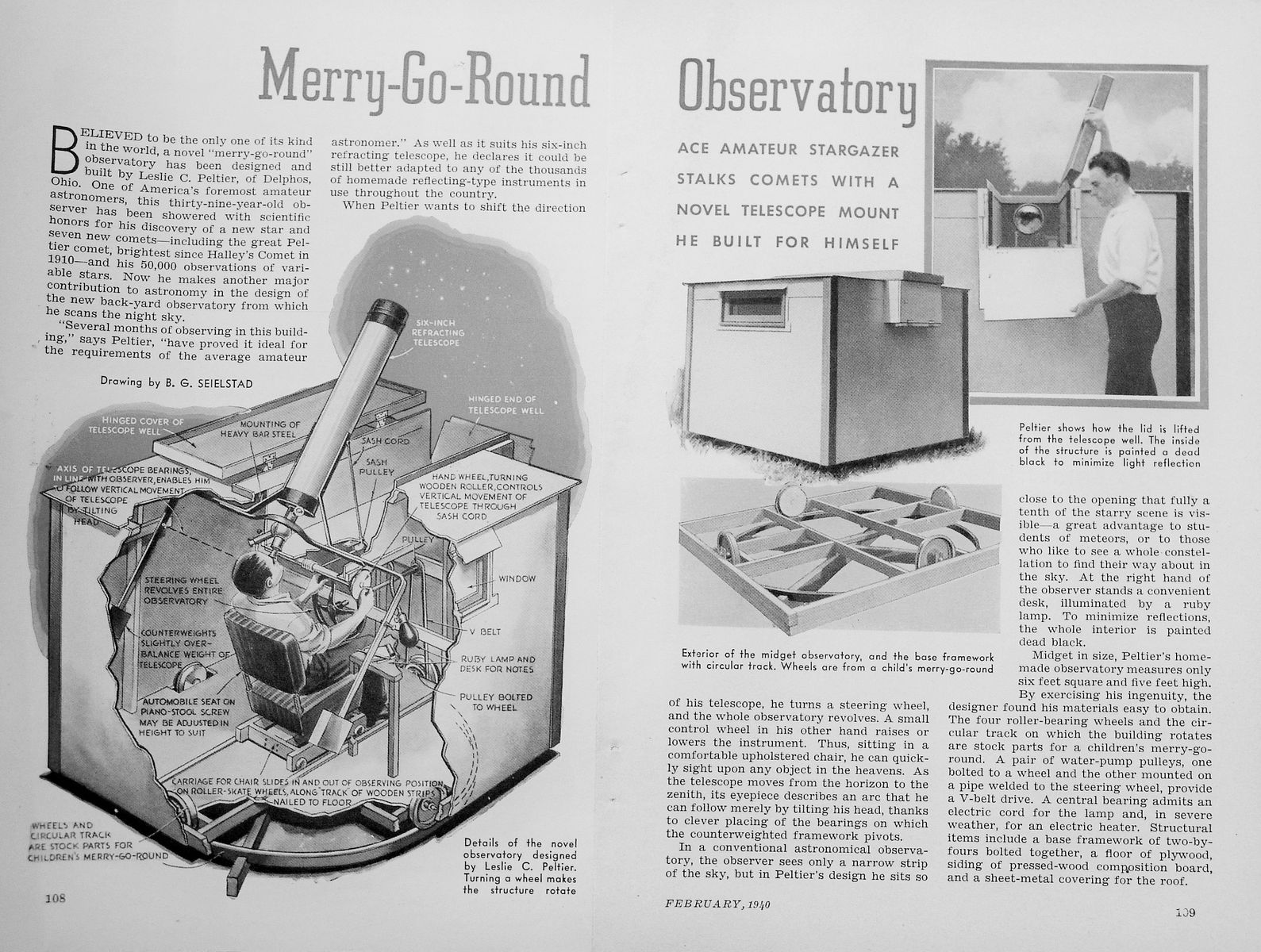Hi all,
About every 2-3 years I re-read Leslie Peltier's Starlight Nights. There is just something about this book that renews a sublime connection with the night sky that I cherish so much.
After a recent observing session in which I strained my neck a bit too much (ouch), I was thinking about the Merry-Go-Round observatory that Peltier constructed and used with a six-inch refractor. The observatory, clearly rather unique, was designed primarily to allow rapid visual estimates of variable stars. What I specifically have been thinking about is that the observer sits in a comfortable chair (a scavenged car seat in Peltier's case) while they observe. In a large sense, Peltier's design was the precursor to those bino-chairs that have popped up in recent decades. The more I think about it....the design is actually fairly (overly?) intricate, but all of your star charts rotate with you, and there is something to be said for that. :)
I'm wondering, is anyone aware of anyone implementing their own design of Peltier's unique observatory?
(Below is a 1940's article (I am unsure of what publication) that has a good detailed drawing of the observatory for those unfamiliar with it.)

--Michael in Houston (RMW)



Very interesting, Michael, I have been considering ideas for implementing a lightweight version.
No comments have been posted here, and so I would be starting from scratch!
I'm not sure what sort of child's merry-go-rounds were in common backyard use in Peltier's day but the steel ring might be a challenge to find without custom fabrication.
Actually, my thoughts are that I might use hard 1-1/2" or 2" diameter PVC tubing for a light-duty ring that would support the weight of a small platform. It would be ideal for a chair and frame with scope or big binocs (25x100) that could rotate using the manual pulley drive mechanism illustrated in the Peltier drawing. The whole thing may not need to be more than 3-4 ft in diameter, and then this rotating platform could be covered by any sort of stationary shed (roll-off roof, flip-off roof, etc) separate from and surrounding the rotating platform (or just a tarp with the scope removed).
Another crucial feature is that a support frame of some sort for the scope would be suitable for celestial objects at a fixed height in the sky (perhaps 45-60 deg elevation above the horizon) for a seated observer, unless a height adjustment mechanism is built to raise or lower the scope. This would be fine; I could spend all night observing variable stars passing through this altitude zone.
Frank
My old friend, the late Gerry Dyck of Massachusetts, built a Peltier-inspired Merry-Go-Round observatory for his homemade 17 1/2-inch Dobsonian. Gerry used this setup to become the most productive AAVSO observer in the Northern Hemisphere of the Earth for some years in the 1980s. He was written up circa 1985 in an article about AAVSO in Air & Space Smithsonian magazine. There were surely other write-ups that particularly focused on his observatory design; there must have been one in Sky & Telescope. The first incarnation of his observatory was "High Hill Observatory," which was a roll-off housing a 10-inch in North Dartmouth. But before long Gerry developed the setup for his 17 1/2-inch, which was fabulous for visual variable star work. And he loved the work.
--John W. Briggs, with Gerry, a former member of the Greater New Bedford Astronomical Society.
error
Here is a link to one of the articles about Gerry Dyck's merry-go-round observatory:
http://www.theskyscrapers.org/gerry-dyck-merry-go-round-observatory#!prettyPhoto[gallery2]/20/